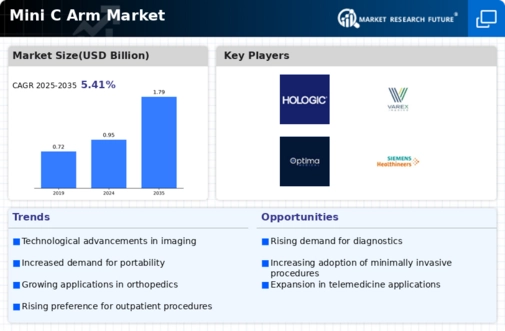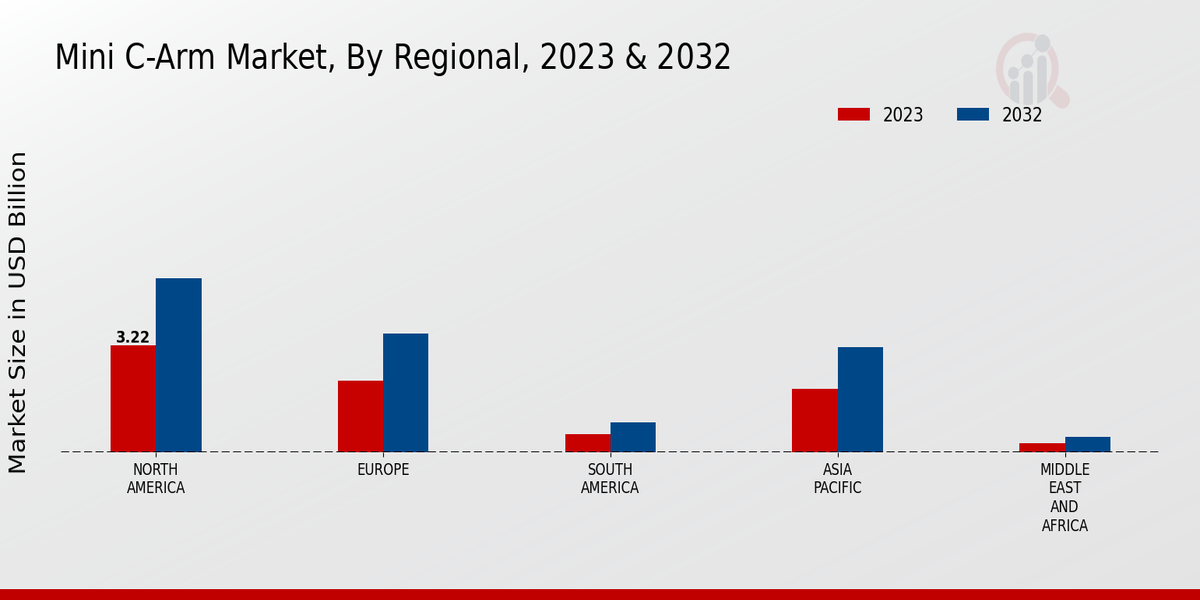Technological Advancements
The Global Mini C Arm Market Industry is experiencing a surge in demand due to rapid technological advancements. Innovations in imaging technology, such as improved resolution and enhanced portability, are making mini C-arms more appealing to healthcare providers. For instance, the integration of digital imaging and wireless connectivity allows for real-time data sharing and analysis, which enhances surgical precision. As a result, the market is projected to reach 0.95 USD Billion in 2024, reflecting a growing preference for these advanced devices in various medical settings.
Rising Geriatric Population
The aging population worldwide is a significant driver of the Global Mini C Arm Market Industry. As individuals age, they often require more medical interventions, particularly in orthopedics and pain management. Mini C-arms are increasingly utilized in these fields due to their ability to provide detailed imaging in a compact format. The growing geriatric demographic is likely to increase the demand for these devices, as healthcare systems adapt to meet the needs of older patients. This demographic shift suggests a sustained growth trajectory for the market, with a projected CAGR of 5.94% from 2025 to 2035.
Market Trends and Projections
The Global Mini C Arm Market Industry is poised for substantial growth, with projections indicating a market size of 0.95 USD Billion in 2024 and an anticipated increase to 1.79 USD Billion by 2035. The compound annual growth rate (CAGR) is estimated at 5.94% from 2025 to 2035, reflecting a robust demand for mini C-arms driven by technological advancements, increasing procedural demands, and demographic shifts. These trends suggest a dynamic and evolving market landscape, where mini C-arms are becoming integral to modern medical imaging and surgical practices.
Cost-Effectiveness of Mini C Arms
Cost-effectiveness is a pivotal factor influencing the Global Mini C Arm Market Industry. These devices typically require lower initial investment and operational costs compared to traditional C-arms, making them accessible for smaller healthcare facilities and outpatient clinics. The affordability of mini C-arms enables a broader range of medical institutions to incorporate advanced imaging technology into their practices. This trend is likely to enhance market penetration, as more facilities recognize the financial benefits of adopting mini C-arms, thereby contributing to the overall growth of the industry.
Regulatory Support and Reimbursement Policies
Regulatory support and favorable reimbursement policies are fostering growth in the Global Mini C Arm Market Industry. Governments and health organizations are increasingly recognizing the value of advanced imaging technologies in improving patient outcomes. As a result, there are ongoing efforts to streamline the approval processes for medical devices, including mini C-arms. Additionally, reimbursement policies that cover the use of these devices in various procedures encourage healthcare providers to adopt them. This supportive regulatory environment is anticipated to bolster market growth, as it facilitates wider acceptance and utilization of mini C-arms across healthcare settings.
Increasing Demand for Minimally Invasive Procedures
There is a notable increase in the demand for minimally invasive procedures, which is driving growth in the Global Mini C Arm Market Industry. These procedures are associated with reduced recovery times and lower complication rates, making them preferable for both patients and healthcare providers. Mini C-arms play a crucial role in facilitating these procedures by providing high-quality imaging with minimal radiation exposure. This trend is expected to contribute to the market's expansion, with projections indicating a rise to 1.79 USD Billion by 2035, underscoring the importance of mini C-arms in modern surgical practices.
















Leave a Comment